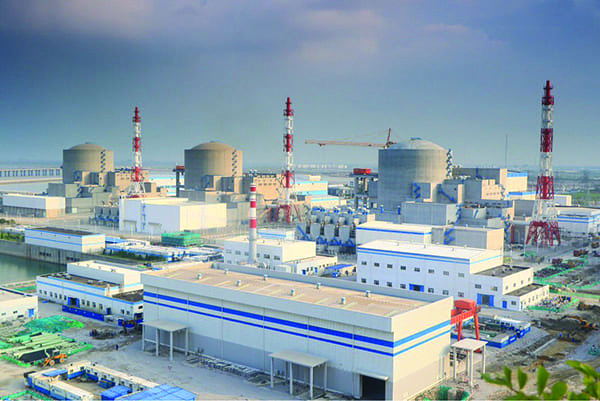Russia Sets New Domestic Nuclear Generation Record
Rosenergoatom, Russia's state-owned nuclear plant owner and operator, said it set another nuclear power production record in 2018. The company generated 204 TWh from its 35 reactors-1.4 TWh more than in 2017-supplying 18.7% of the Russian Federation's total electricity. "Thus, each fifth electric bulb in the Russian Federation is lit owing to energy produced at nuclear power plants," the company said on Jan. 9.
The feat is remarkable for Russia, even considering the country's lengthy nuclear power history and vast expertise, because it demonstrates the country's optimism for nuclear generation-despite a recent decline in Russian power demand, and a generally dismal outlook for nuclear power elsewhere around the world.
Russia's nuclear history kicked off in 1937 with the start of experimental studies on the structure of atomic nuclei. By 1946, it achieved a controlled uranium fission chain reaction in a lab, and in 1954, it pioneered the world's very first nuclear power plant (the 5-MWe Obninsk reactor). By 1965, it had commissioned the first commercial water-moderated, water-cooled vessel type (VVER) reactor at Novovoronezh, as well as the first commercial boiling water-cooled graphite-moderated reactor with nuclear superheating of steam at Beloyarsk. And then in 1973, it commissioned the first commercial water-cooled graphite-moderated channel-type (RBMK) reactor at Leningrad, and a fast reactor at Beloyarsk in 1980.
Between the 1986 Chernobyl accident and the mid-1990s, only one nuclear power station was commissioned in Russia (the four-unit Balakovo plant). Further development was restrained by an acute shortage of funds after the collapse of the Soviet bloc. But since 2001, Russia has put online Rostov 1 (in 2001), 2 (in 2010), and 3 (in 2014); Kalinin 3 (in 2004) and 4 (in 2011); and Beloyarsk 4, a fast reactor, in 2015. More recently, it began operations at Novovoronezh II Unit 1 in 2016, followed by Rostov 4 in February 2018, and Leningrad II Unit 1 in September 2018.
For Rosenergoatom, which was founded in 1992 and is today overseen by Rosatom, Russia's giant state atomic energy corporation, the increase in power generation is in line with the company's 2017 directive to improve financial performance and optimize management. Cost efficiency is also a key driver. Rosatom recently suggested it slashed the cost of electricity production at its nuclear power plants by 36% between 2011 to 2017.
The plants that made the most remarkable contributions to the country's nuclear generation record were Kalinin (which produced 35 TWh), Balakovo (31 TWh), and Leningrad (28 TWh). The achievements stem partly from a program introduced in July 2012 that envisaged increasing the power of VVER-440 units to 107%, that of RBMKs to 105%, and VVER-1000 units to 107% to 110%. By May 2015, Rosenergoatom said it had completed uprating all VVER-1000 reactors to 104% of rated power and was starting to take them to 107% using the advanced TVS-2M fuel design, starting with Balakovo 4. Measures included testing fuels, for example, to extend VVER-1000 reactors from the current 18-month fuel cycle to a 24-month fuel cycle.
In January, Rosatom also said the first Russian-made experimental nuclear fuel assemblies based on accident-tolerant fuel (ATF) had been loaded for testing into the water loops of the MIR research reactor at the State Research Institute of Atomic Reactors in the Ulyanovsk Region. It said two experimental fuel assemblies, manufactured at the Novosibirsk Chemical Concentrates Plant [a subsidiary of Rosatom's TVEL Fuel Co., which provides nuclear fuel for 72 reactors in 14 countries, including the Russian fleet], were installed, consisting of either VVER or PWR geometry fuel rods with four different combinations of cladding materials and fuel matrix. "Fuel pellets are made of one of the two materials, either traditional uranium dioxide or uranium-molybdenum alloy with increased density and thermal conductivity. The fuel rods cladding is either a zirconium alloy with chromium coating or a chromium-nickel alloy," it added. The first phase of the ATF reactor tests and post reactor studies should be completed in 2019.
For Rosatom, meanwhile, the record-breaking generation numbers are another selling point in its drive to expand its portfolio of foreign construction projects, which has become key to its financial viability. This is because in 2017, Rosatom's CEO reportedly suggested Russia's government would end state-support for the construction of new nuclear units in 2020. So far, the company-which has the second-largest uranium reserves and 17% of the global nuclear fuel market-has built or is currently building 36 nuclear power plants in 12 countries. In 2018, Rosatom's package of foreign orders exceeded $130 billion, it noted.
 Units 3 and 4 at Tianwan Phase II in China's Jiangsu province-two AES-91 VVER-1000 units designed by Gidropress and supplied by Rosatom-entered commercial operation in February 2018 and October 2018. In November, Rosatom said its engineering division AtomStroyExport signed four executive contracts with China National Nuclear Corp. for construction of Tianwan 7 and 8. Construction on Tianwan units 5 and 6-two 1,080 MWe ACPR1000 reactors-is slated to be completed in 2021. Courtesy: Rosatom |
Since December 2017, the company has marked some significant milestones. It launched construction of two VVERs, a total 2.4 GW, at Rooppur in Bangladesh, as well as at the Akkuyu site in Turkey. Last year, Tianwan 3 and 4 (Figure 6), projects Rosatom built under a cooperation agreement with China, reached first power, and the company got closer to launching commercial operation of two KLT-40S reactor units atop the "Akademik Lomonosov," a floating nuclear power plant that will replace the "technologically outdated" Bilibino nuclear power plant this year.
-Sonal Patelis a POWER associate editor.
The post Russia Sets New Domestic Nuclear Generation Record appeared first on POWER Magazine.